Business Communication Skills: Article Analysis - Report on Governance
VerifiedAdded on 2023/03/17
|8
|2184
|28
Report
AI Summary
This report provides a critical review of two articles related to business communication skills, specifically focusing on governance within charitable organizations and Not-for-Profit (NFP) firms. The analysis begins by outlining the key arguments presented in each article, highlighting recommendations and the rationale behind them. The first article, "Governance for Good," discusses the roles and responsibilities of board members in Australian charities, emphasizing payment policies, charitable purposes, and compliance with ACNC governance standards. The second article explores the governance of NFP firms, examining their legal liabilities, stakeholder management, and the importance of a clearly defined purpose. The report then critically evaluates the differences between the two articles, particularly in terms of the evidence used to support their arguments. It highlights how the first article centers on board member actions and the ACNC's regulatory framework, while the second focuses on the operational and governance challenges faced by NFP firms. The evaluation emphasizes the distinct perspectives and evidence presented by each article, contributing to a comprehensive understanding of governance challenges in these sectors.
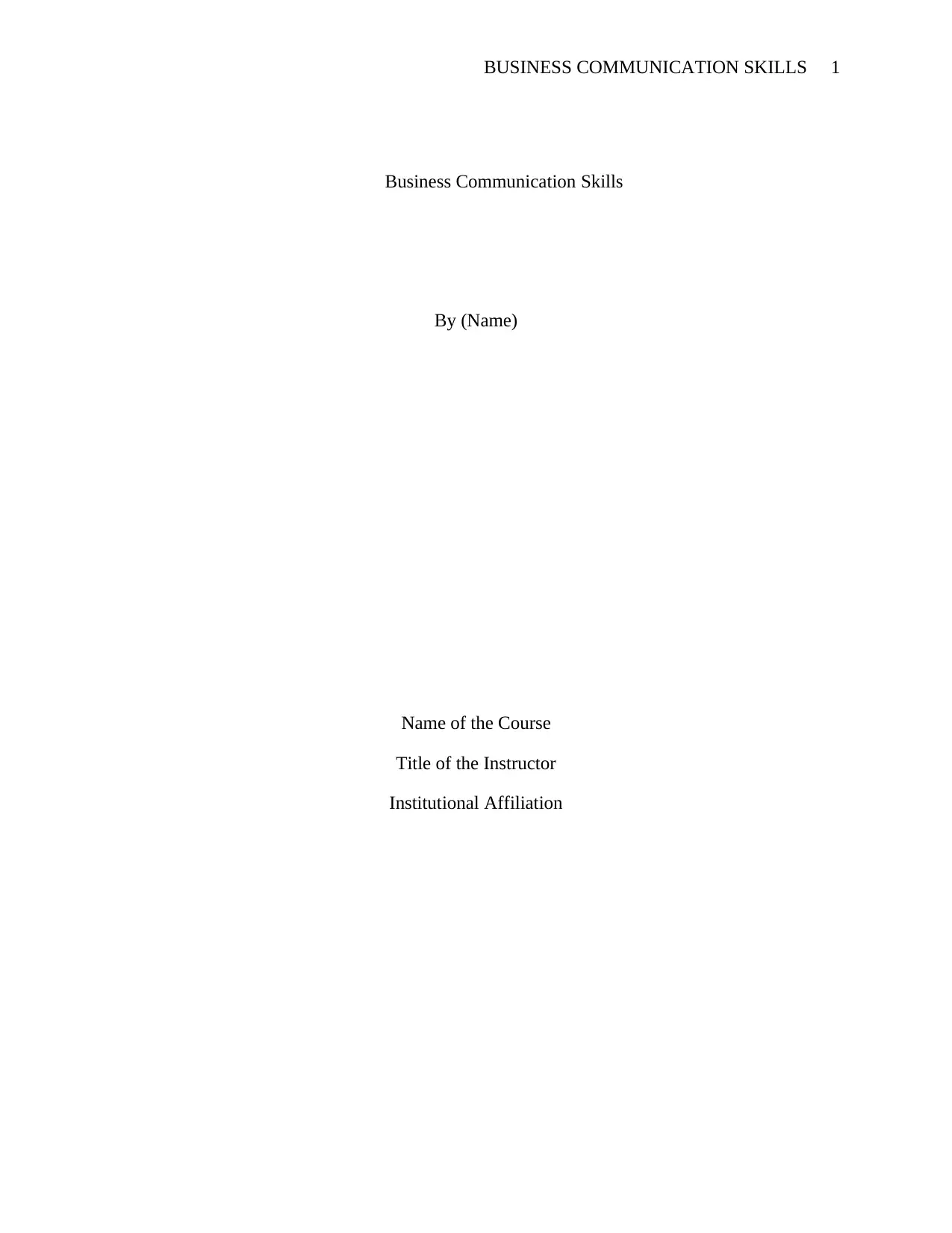
BUSINESS COMMUNICATION SKILLS 1
Business Communication Skills
By (Name)
Name of the Course
Title of the Instructor
Institutional Affiliation
Business Communication Skills
By (Name)
Name of the Course
Title of the Instructor
Institutional Affiliation
Paraphrase This Document
Need a fresh take? Get an instant paraphrase of this document with our AI Paraphraser
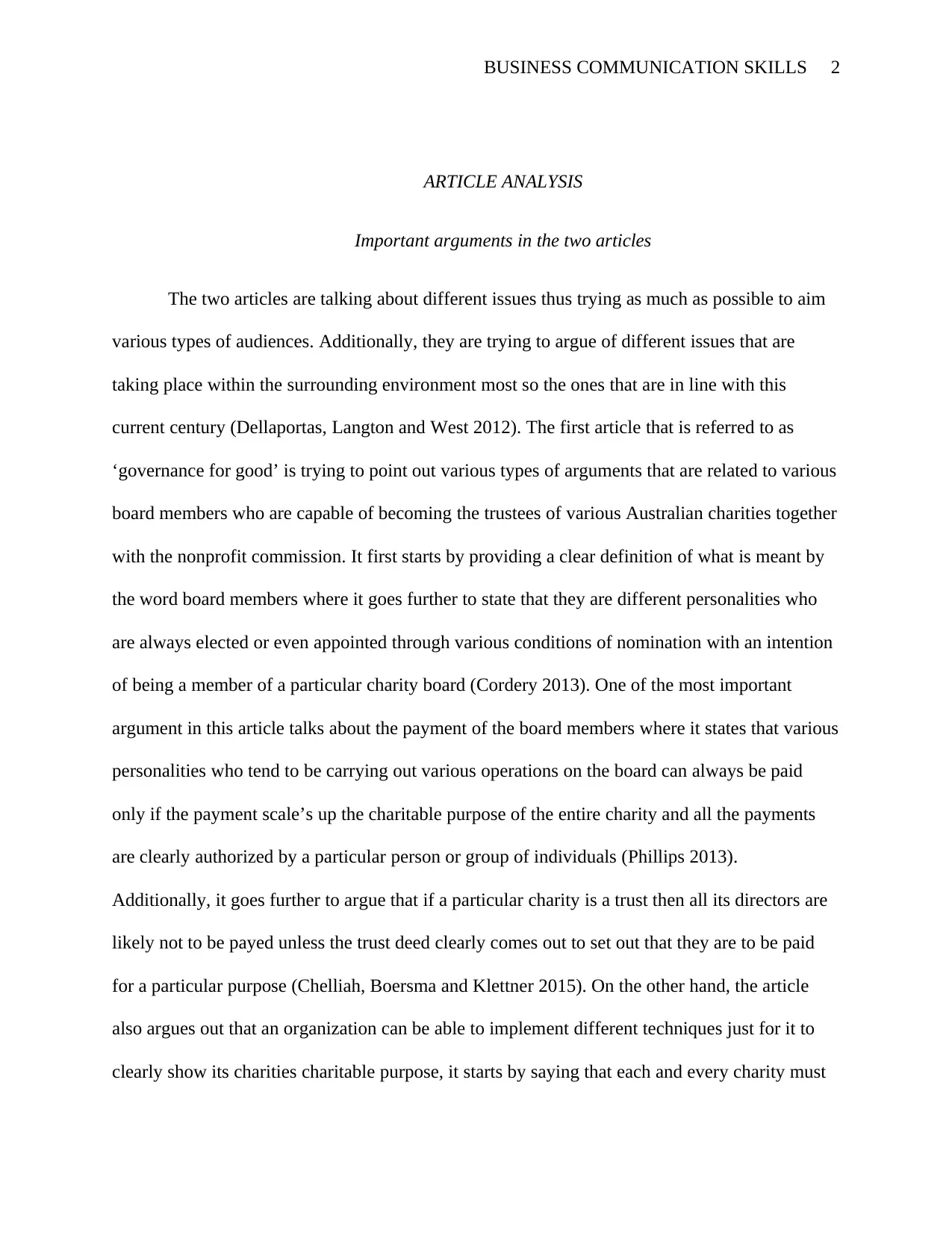
BUSINESS COMMUNICATION SKILLS 2
ARTICLE ANALYSIS
Important arguments in the two articles
The two articles are talking about different issues thus trying as much as possible to aim
various types of audiences. Additionally, they are trying to argue of different issues that are
taking place within the surrounding environment most so the ones that are in line with this
current century (Dellaportas, Langton and West 2012). The first article that is referred to as
‘governance for good’ is trying to point out various types of arguments that are related to various
board members who are capable of becoming the trustees of various Australian charities together
with the nonprofit commission. It first starts by providing a clear definition of what is meant by
the word board members where it goes further to state that they are different personalities who
are always elected or even appointed through various conditions of nomination with an intention
of being a member of a particular charity board (Cordery 2013). One of the most important
argument in this article talks about the payment of the board members where it states that various
personalities who tend to be carrying out various operations on the board can always be paid
only if the payment scale’s up the charitable purpose of the entire charity and all the payments
are clearly authorized by a particular person or group of individuals (Phillips 2013).
Additionally, it goes further to argue that if a particular charity is a trust then all its directors are
likely not to be payed unless the trust deed clearly comes out to set out that they are to be paid
for a particular purpose (Chelliah, Boersma and Klettner 2015). On the other hand, the article
also argues out that an organization can be able to implement different techniques just for it to
clearly show its charities charitable purpose, it starts by saying that each and every charity must
ARTICLE ANALYSIS
Important arguments in the two articles
The two articles are talking about different issues thus trying as much as possible to aim
various types of audiences. Additionally, they are trying to argue of different issues that are
taking place within the surrounding environment most so the ones that are in line with this
current century (Dellaportas, Langton and West 2012). The first article that is referred to as
‘governance for good’ is trying to point out various types of arguments that are related to various
board members who are capable of becoming the trustees of various Australian charities together
with the nonprofit commission. It first starts by providing a clear definition of what is meant by
the word board members where it goes further to state that they are different personalities who
are always elected or even appointed through various conditions of nomination with an intention
of being a member of a particular charity board (Cordery 2013). One of the most important
argument in this article talks about the payment of the board members where it states that various
personalities who tend to be carrying out various operations on the board can always be paid
only if the payment scale’s up the charitable purpose of the entire charity and all the payments
are clearly authorized by a particular person or group of individuals (Phillips 2013).
Additionally, it goes further to argue that if a particular charity is a trust then all its directors are
likely not to be payed unless the trust deed clearly comes out to set out that they are to be paid
for a particular purpose (Chelliah, Boersma and Klettner 2015). On the other hand, the article
also argues out that an organization can be able to implement different techniques just for it to
clearly show its charities charitable purpose, it starts by saying that each and every charity must
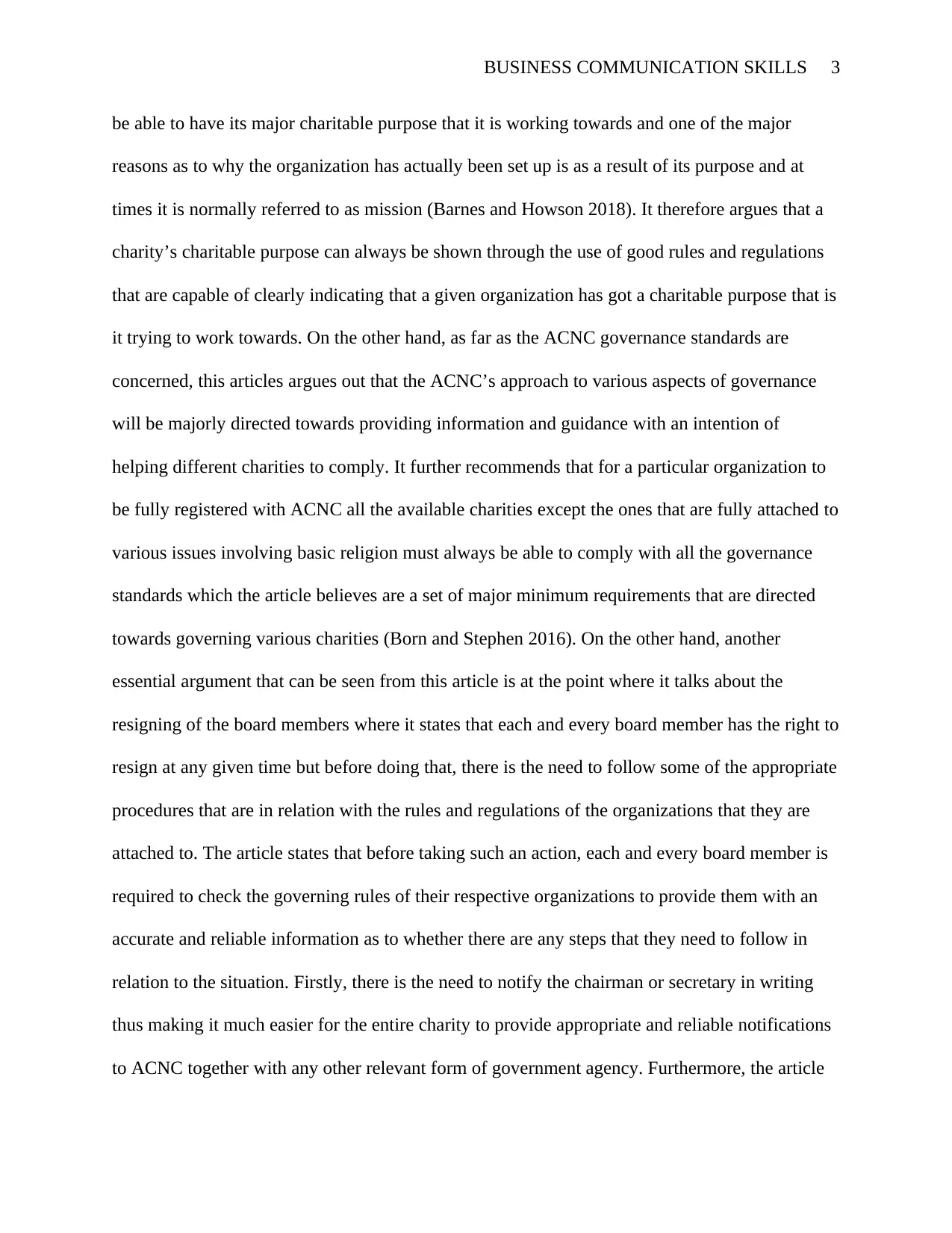
BUSINESS COMMUNICATION SKILLS 3
be able to have its major charitable purpose that it is working towards and one of the major
reasons as to why the organization has actually been set up is as a result of its purpose and at
times it is normally referred to as mission (Barnes and Howson 2018). It therefore argues that a
charity’s charitable purpose can always be shown through the use of good rules and regulations
that are capable of clearly indicating that a given organization has got a charitable purpose that is
it trying to work towards. On the other hand, as far as the ACNC governance standards are
concerned, this articles argues out that the ACNC’s approach to various aspects of governance
will be majorly directed towards providing information and guidance with an intention of
helping different charities to comply. It further recommends that for a particular organization to
be fully registered with ACNC all the available charities except the ones that are fully attached to
various issues involving basic religion must always be able to comply with all the governance
standards which the article believes are a set of major minimum requirements that are directed
towards governing various charities (Born and Stephen 2016). On the other hand, another
essential argument that can be seen from this article is at the point where it talks about the
resigning of the board members where it states that each and every board member has the right to
resign at any given time but before doing that, there is the need to follow some of the appropriate
procedures that are in relation with the rules and regulations of the organizations that they are
attached to. The article states that before taking such an action, each and every board member is
required to check the governing rules of their respective organizations to provide them with an
accurate and reliable information as to whether there are any steps that they need to follow in
relation to the situation. Firstly, there is the need to notify the chairman or secretary in writing
thus making it much easier for the entire charity to provide appropriate and reliable notifications
to ACNC together with any other relevant form of government agency. Furthermore, the article
be able to have its major charitable purpose that it is working towards and one of the major
reasons as to why the organization has actually been set up is as a result of its purpose and at
times it is normally referred to as mission (Barnes and Howson 2018). It therefore argues that a
charity’s charitable purpose can always be shown through the use of good rules and regulations
that are capable of clearly indicating that a given organization has got a charitable purpose that is
it trying to work towards. On the other hand, as far as the ACNC governance standards are
concerned, this articles argues out that the ACNC’s approach to various aspects of governance
will be majorly directed towards providing information and guidance with an intention of
helping different charities to comply. It further recommends that for a particular organization to
be fully registered with ACNC all the available charities except the ones that are fully attached to
various issues involving basic religion must always be able to comply with all the governance
standards which the article believes are a set of major minimum requirements that are directed
towards governing various charities (Born and Stephen 2016). On the other hand, another
essential argument that can be seen from this article is at the point where it talks about the
resigning of the board members where it states that each and every board member has the right to
resign at any given time but before doing that, there is the need to follow some of the appropriate
procedures that are in relation with the rules and regulations of the organizations that they are
attached to. The article states that before taking such an action, each and every board member is
required to check the governing rules of their respective organizations to provide them with an
accurate and reliable information as to whether there are any steps that they need to follow in
relation to the situation. Firstly, there is the need to notify the chairman or secretary in writing
thus making it much easier for the entire charity to provide appropriate and reliable notifications
to ACNC together with any other relevant form of government agency. Furthermore, the article
⊘ This is a preview!⊘
Do you want full access?
Subscribe today to unlock all pages.

Trusted by 1+ million students worldwide
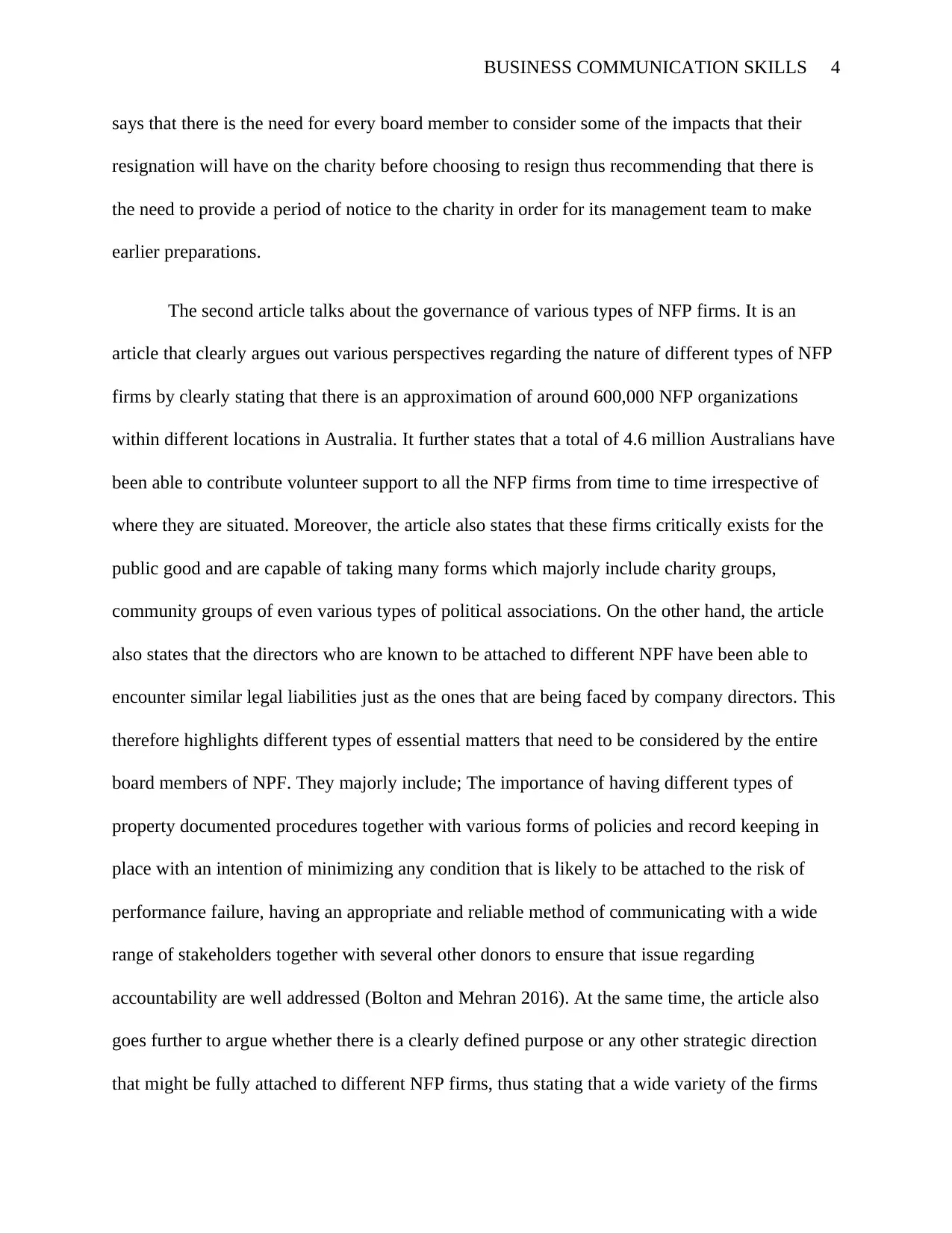
BUSINESS COMMUNICATION SKILLS 4
says that there is the need for every board member to consider some of the impacts that their
resignation will have on the charity before choosing to resign thus recommending that there is
the need to provide a period of notice to the charity in order for its management team to make
earlier preparations.
The second article talks about the governance of various types of NFP firms. It is an
article that clearly argues out various perspectives regarding the nature of different types of NFP
firms by clearly stating that there is an approximation of around 600,000 NFP organizations
within different locations in Australia. It further states that a total of 4.6 million Australians have
been able to contribute volunteer support to all the NFP firms from time to time irrespective of
where they are situated. Moreover, the article also states that these firms critically exists for the
public good and are capable of taking many forms which majorly include charity groups,
community groups of even various types of political associations. On the other hand, the article
also states that the directors who are known to be attached to different NPF have been able to
encounter similar legal liabilities just as the ones that are being faced by company directors. This
therefore highlights different types of essential matters that need to be considered by the entire
board members of NPF. They majorly include; The importance of having different types of
property documented procedures together with various forms of policies and record keeping in
place with an intention of minimizing any condition that is likely to be attached to the risk of
performance failure, having an appropriate and reliable method of communicating with a wide
range of stakeholders together with several other donors to ensure that issue regarding
accountability are well addressed (Bolton and Mehran 2016). At the same time, the article also
goes further to argue whether there is a clearly defined purpose or any other strategic direction
that might be fully attached to different NFP firms, thus stating that a wide variety of the firms
says that there is the need for every board member to consider some of the impacts that their
resignation will have on the charity before choosing to resign thus recommending that there is
the need to provide a period of notice to the charity in order for its management team to make
earlier preparations.
The second article talks about the governance of various types of NFP firms. It is an
article that clearly argues out various perspectives regarding the nature of different types of NFP
firms by clearly stating that there is an approximation of around 600,000 NFP organizations
within different locations in Australia. It further states that a total of 4.6 million Australians have
been able to contribute volunteer support to all the NFP firms from time to time irrespective of
where they are situated. Moreover, the article also states that these firms critically exists for the
public good and are capable of taking many forms which majorly include charity groups,
community groups of even various types of political associations. On the other hand, the article
also states that the directors who are known to be attached to different NPF have been able to
encounter similar legal liabilities just as the ones that are being faced by company directors. This
therefore highlights different types of essential matters that need to be considered by the entire
board members of NPF. They majorly include; The importance of having different types of
property documented procedures together with various forms of policies and record keeping in
place with an intention of minimizing any condition that is likely to be attached to the risk of
performance failure, having an appropriate and reliable method of communicating with a wide
range of stakeholders together with several other donors to ensure that issue regarding
accountability are well addressed (Bolton and Mehran 2016). At the same time, the article also
goes further to argue whether there is a clearly defined purpose or any other strategic direction
that might be fully attached to different NFP firms, thus stating that a wide variety of the firms
Paraphrase This Document
Need a fresh take? Get an instant paraphrase of this document with our AI Paraphraser
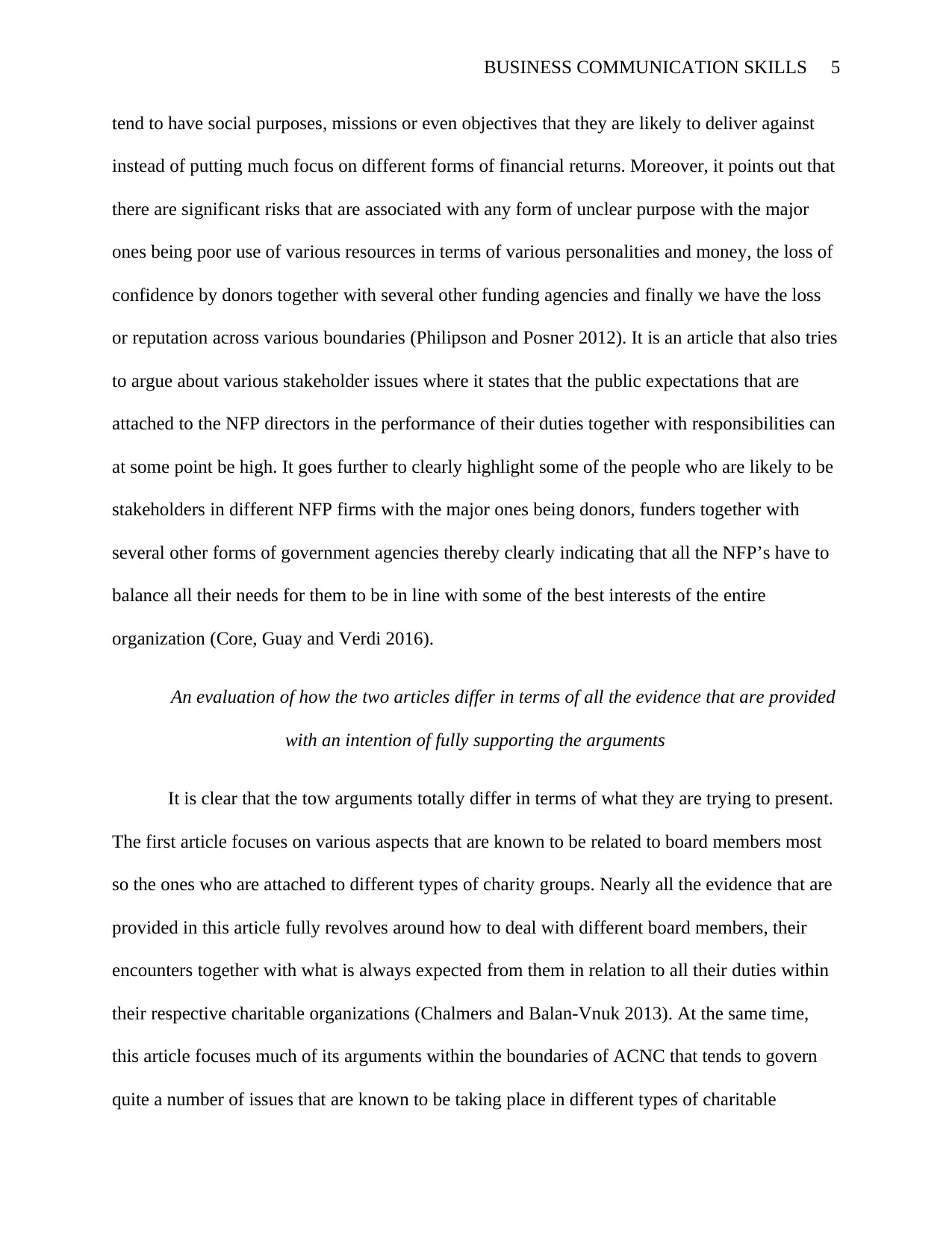
BUSINESS COMMUNICATION SKILLS 5
tend to have social purposes, missions or even objectives that they are likely to deliver against
instead of putting much focus on different forms of financial returns. Moreover, it points out that
there are significant risks that are associated with any form of unclear purpose with the major
ones being poor use of various resources in terms of various personalities and money, the loss of
confidence by donors together with several other funding agencies and finally we have the loss
or reputation across various boundaries (Philipson and Posner 2012). It is an article that also tries
to argue about various stakeholder issues where it states that the public expectations that are
attached to the NFP directors in the performance of their duties together with responsibilities can
at some point be high. It goes further to clearly highlight some of the people who are likely to be
stakeholders in different NFP firms with the major ones being donors, funders together with
several other forms of government agencies thereby clearly indicating that all the NFP’s have to
balance all their needs for them to be in line with some of the best interests of the entire
organization (Core, Guay and Verdi 2016).
An evaluation of how the two articles differ in terms of all the evidence that are provided
with an intention of fully supporting the arguments
It is clear that the tow arguments totally differ in terms of what they are trying to present.
The first article focuses on various aspects that are known to be related to board members most
so the ones who are attached to different types of charity groups. Nearly all the evidence that are
provided in this article fully revolves around how to deal with different board members, their
encounters together with what is always expected from them in relation to all their duties within
their respective charitable organizations (Chalmers and Balan-Vnuk 2013). At the same time,
this article focuses much of its arguments within the boundaries of ACNC that tends to govern
quite a number of issues that are known to be taking place in different types of charitable
tend to have social purposes, missions or even objectives that they are likely to deliver against
instead of putting much focus on different forms of financial returns. Moreover, it points out that
there are significant risks that are associated with any form of unclear purpose with the major
ones being poor use of various resources in terms of various personalities and money, the loss of
confidence by donors together with several other funding agencies and finally we have the loss
or reputation across various boundaries (Philipson and Posner 2012). It is an article that also tries
to argue about various stakeholder issues where it states that the public expectations that are
attached to the NFP directors in the performance of their duties together with responsibilities can
at some point be high. It goes further to clearly highlight some of the people who are likely to be
stakeholders in different NFP firms with the major ones being donors, funders together with
several other forms of government agencies thereby clearly indicating that all the NFP’s have to
balance all their needs for them to be in line with some of the best interests of the entire
organization (Core, Guay and Verdi 2016).
An evaluation of how the two articles differ in terms of all the evidence that are provided
with an intention of fully supporting the arguments
It is clear that the tow arguments totally differ in terms of what they are trying to present.
The first article focuses on various aspects that are known to be related to board members most
so the ones who are attached to different types of charity groups. Nearly all the evidence that are
provided in this article fully revolves around how to deal with different board members, their
encounters together with what is always expected from them in relation to all their duties within
their respective charitable organizations (Chalmers and Balan-Vnuk 2013). At the same time,
this article focuses much of its arguments within the boundaries of ACNC that tends to govern
quite a number of issues that are known to be taking place in different types of charitable
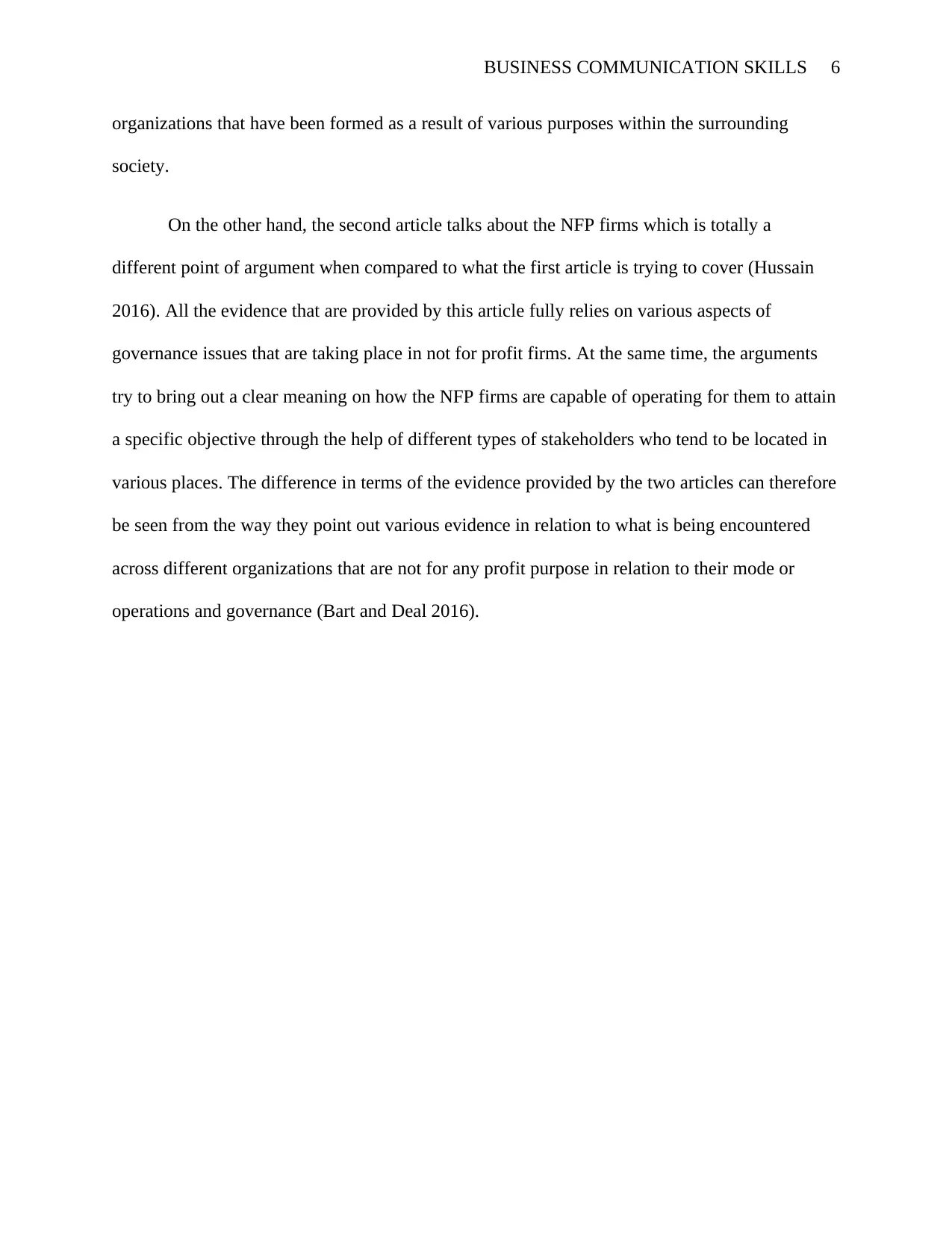
BUSINESS COMMUNICATION SKILLS 6
organizations that have been formed as a result of various purposes within the surrounding
society.
On the other hand, the second article talks about the NFP firms which is totally a
different point of argument when compared to what the first article is trying to cover (Hussain
2016). All the evidence that are provided by this article fully relies on various aspects of
governance issues that are taking place in not for profit firms. At the same time, the arguments
try to bring out a clear meaning on how the NFP firms are capable of operating for them to attain
a specific objective through the help of different types of stakeholders who tend to be located in
various places. The difference in terms of the evidence provided by the two articles can therefore
be seen from the way they point out various evidence in relation to what is being encountered
across different organizations that are not for any profit purpose in relation to their mode or
operations and governance (Bart and Deal 2016).
organizations that have been formed as a result of various purposes within the surrounding
society.
On the other hand, the second article talks about the NFP firms which is totally a
different point of argument when compared to what the first article is trying to cover (Hussain
2016). All the evidence that are provided by this article fully relies on various aspects of
governance issues that are taking place in not for profit firms. At the same time, the arguments
try to bring out a clear meaning on how the NFP firms are capable of operating for them to attain
a specific objective through the help of different types of stakeholders who tend to be located in
various places. The difference in terms of the evidence provided by the two articles can therefore
be seen from the way they point out various evidence in relation to what is being encountered
across different organizations that are not for any profit purpose in relation to their mode or
operations and governance (Bart and Deal 2016).
⊘ This is a preview!⊘
Do you want full access?
Subscribe today to unlock all pages.

Trusted by 1+ million students worldwide
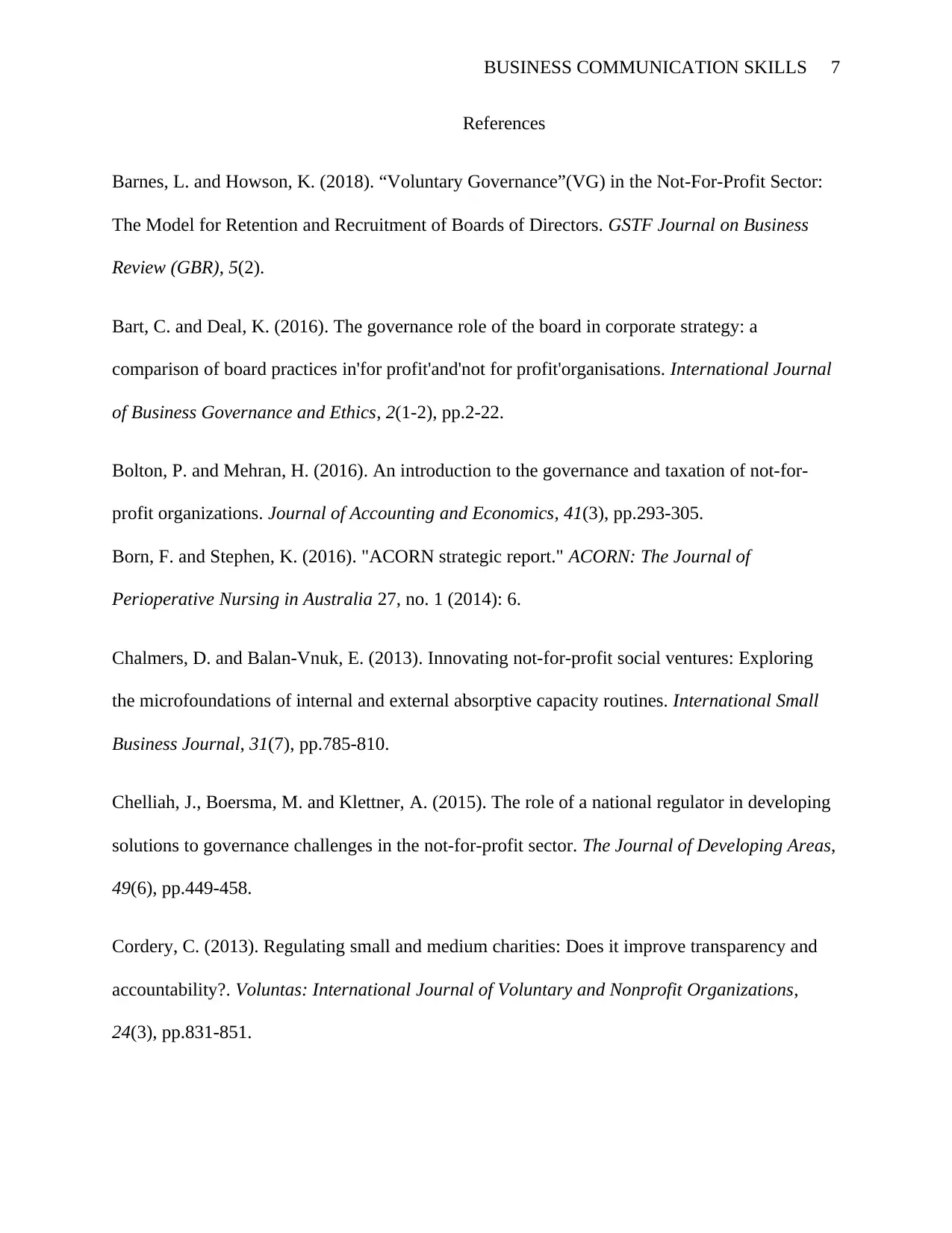
BUSINESS COMMUNICATION SKILLS 7
References
Barnes, L. and Howson, K. (2018). “Voluntary Governance”(VG) in the Not-For-Profit Sector:
The Model for Retention and Recruitment of Boards of Directors. GSTF Journal on Business
Review (GBR), 5(2).
Bart, C. and Deal, K. (2016). The governance role of the board in corporate strategy: a
comparison of board practices in'for profit'and'not for profit'organisations. International Journal
of Business Governance and Ethics, 2(1-2), pp.2-22.
Bolton, P. and Mehran, H. (2016). An introduction to the governance and taxation of not-for-
profit organizations. Journal of Accounting and Economics, 41(3), pp.293-305.
Born, F. and Stephen, K. (2016). "ACORN strategic report." ACORN: The Journal of
Perioperative Nursing in Australia 27, no. 1 (2014): 6.
Chalmers, D. and Balan-Vnuk, E. (2013). Innovating not-for-profit social ventures: Exploring
the microfoundations of internal and external absorptive capacity routines. International Small
Business Journal, 31(7), pp.785-810.
Chelliah, J., Boersma, M. and Klettner, A. (2015). The role of a national regulator in developing
solutions to governance challenges in the not-for-profit sector. The Journal of Developing Areas,
49(6), pp.449-458.
Cordery, C. (2013). Regulating small and medium charities: Does it improve transparency and
accountability?. Voluntas: International Journal of Voluntary and Nonprofit Organizations,
24(3), pp.831-851.
References
Barnes, L. and Howson, K. (2018). “Voluntary Governance”(VG) in the Not-For-Profit Sector:
The Model for Retention and Recruitment of Boards of Directors. GSTF Journal on Business
Review (GBR), 5(2).
Bart, C. and Deal, K. (2016). The governance role of the board in corporate strategy: a
comparison of board practices in'for profit'and'not for profit'organisations. International Journal
of Business Governance and Ethics, 2(1-2), pp.2-22.
Bolton, P. and Mehran, H. (2016). An introduction to the governance and taxation of not-for-
profit organizations. Journal of Accounting and Economics, 41(3), pp.293-305.
Born, F. and Stephen, K. (2016). "ACORN strategic report." ACORN: The Journal of
Perioperative Nursing in Australia 27, no. 1 (2014): 6.
Chalmers, D. and Balan-Vnuk, E. (2013). Innovating not-for-profit social ventures: Exploring
the microfoundations of internal and external absorptive capacity routines. International Small
Business Journal, 31(7), pp.785-810.
Chelliah, J., Boersma, M. and Klettner, A. (2015). The role of a national regulator in developing
solutions to governance challenges in the not-for-profit sector. The Journal of Developing Areas,
49(6), pp.449-458.
Cordery, C. (2013). Regulating small and medium charities: Does it improve transparency and
accountability?. Voluntas: International Journal of Voluntary and Nonprofit Organizations,
24(3), pp.831-851.
Paraphrase This Document
Need a fresh take? Get an instant paraphrase of this document with our AI Paraphraser
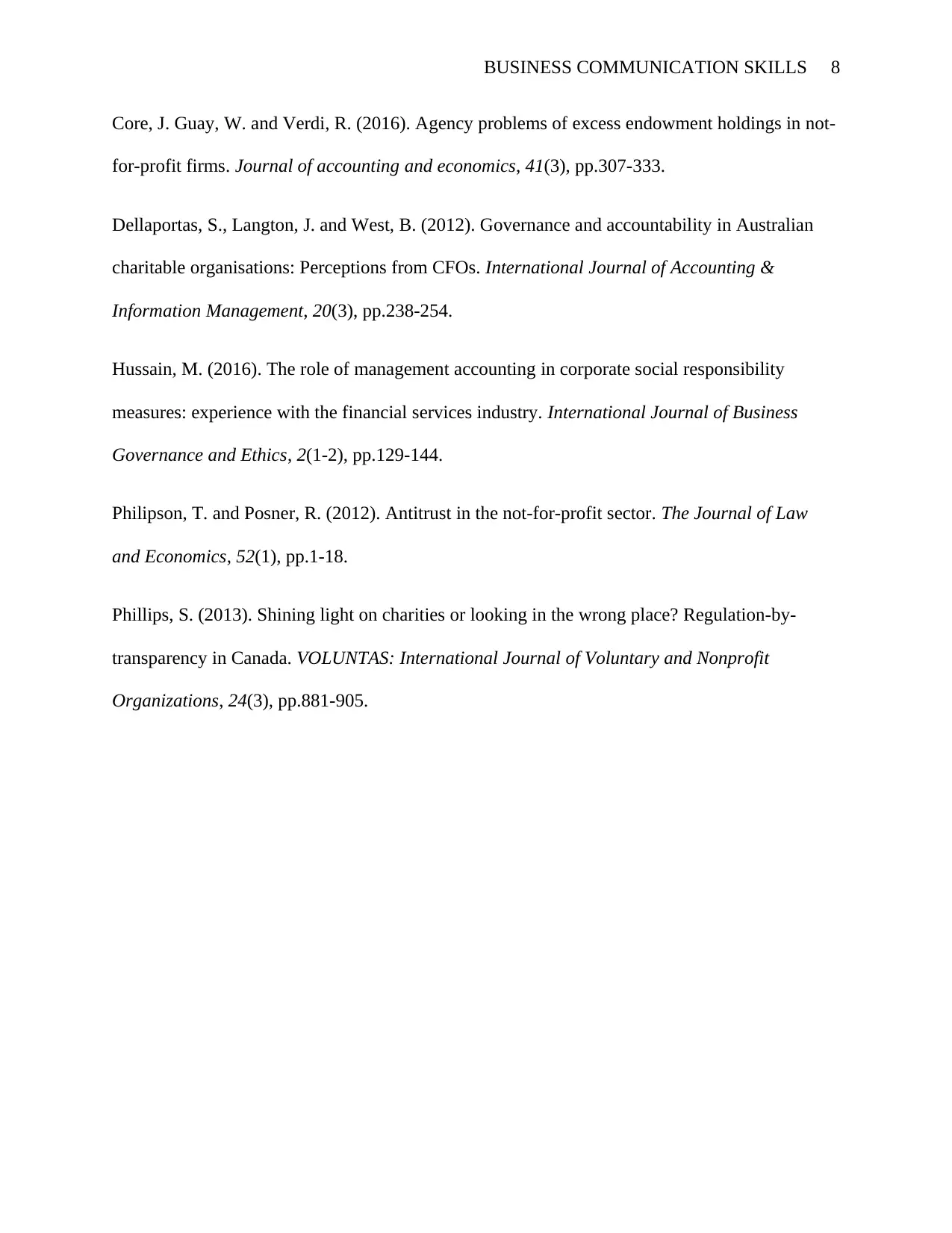
BUSINESS COMMUNICATION SKILLS 8
Core, J. Guay, W. and Verdi, R. (2016). Agency problems of excess endowment holdings in not-
for-profit firms. Journal of accounting and economics, 41(3), pp.307-333.
Dellaportas, S., Langton, J. and West, B. (2012). Governance and accountability in Australian
charitable organisations: Perceptions from CFOs. International Journal of Accounting &
Information Management, 20(3), pp.238-254.
Hussain, M. (2016). The role of management accounting in corporate social responsibility
measures: experience with the financial services industry. International Journal of Business
Governance and Ethics, 2(1-2), pp.129-144.
Philipson, T. and Posner, R. (2012). Antitrust in the not-for-profit sector. The Journal of Law
and Economics, 52(1), pp.1-18.
Phillips, S. (2013). Shining light on charities or looking in the wrong place? Regulation-by-
transparency in Canada. VOLUNTAS: International Journal of Voluntary and Nonprofit
Organizations, 24(3), pp.881-905.
Core, J. Guay, W. and Verdi, R. (2016). Agency problems of excess endowment holdings in not-
for-profit firms. Journal of accounting and economics, 41(3), pp.307-333.
Dellaportas, S., Langton, J. and West, B. (2012). Governance and accountability in Australian
charitable organisations: Perceptions from CFOs. International Journal of Accounting &
Information Management, 20(3), pp.238-254.
Hussain, M. (2016). The role of management accounting in corporate social responsibility
measures: experience with the financial services industry. International Journal of Business
Governance and Ethics, 2(1-2), pp.129-144.
Philipson, T. and Posner, R. (2012). Antitrust in the not-for-profit sector. The Journal of Law
and Economics, 52(1), pp.1-18.
Phillips, S. (2013). Shining light on charities or looking in the wrong place? Regulation-by-
transparency in Canada. VOLUNTAS: International Journal of Voluntary and Nonprofit
Organizations, 24(3), pp.881-905.
1 out of 8
Related Documents
Your All-in-One AI-Powered Toolkit for Academic Success.
+13062052269
info@desklib.com
Available 24*7 on WhatsApp / Email
![[object Object]](/_next/static/media/star-bottom.7253800d.svg)
Unlock your academic potential
Copyright © 2020–2025 A2Z Services. All Rights Reserved. Developed and managed by ZUCOL.



